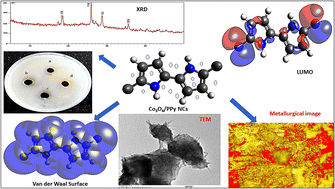Co3O4 quantum dot decorated polypyrrole nanocomposites as a flexible, conducting, anticorrosive and antibacterial agent: sustainable experimental and theoretical approach†
Abstract
Self-assembled cobalt oxide quantum dots (QDs) were prepared by the inverse micelle technique. Polypyrrole (PPy) was synthesized by the chemical-oxidative method. Co3O4 QD-based PPy nanocomposites (NCs) were prepared by an in situ method. The Co3O4 QDs, PPy, and Co3O4@PPy NCs were characterized by TEM, FTIR, X-ray diffraction, and UV-visible techniques. The size of Co3O4 QDs, PPy, and Co3O4@PPy NCs was obtained by powder XRD and TEM methods. Computational (DFT) and adsorption (Langmuir and Henry) studies were carried out to support experimental data. Co3O4@PPy NCs show a maximum of 81.58% protection to mild steel in an acidic medium. The antibacterial activity of Co3O4@PPy NCs was comparable to that of Hexa disk (standard antibiotics). The Co3O4@PPy NCs were proven to be flexible, conducting, corrosion inhibiting, and possess antibacterial properties. The NCs find applications in soft electronics, the pharmaceutical industry, corrosion inhibitors for metals and their alloys, and flexible (moldable) display devices for sustainable developments.

- This article is part of the themed collection: Quantum Dots: Celebrating the 2023 Nobel Prize in Chemistry


 Please wait while we load your content...
Please wait while we load your content...